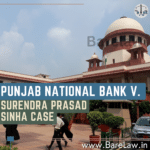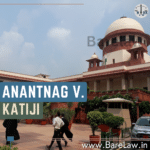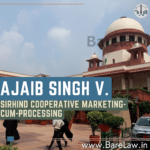
Table of Contents
Ram Baran Prasad v. Ram Mohit Hazra, AIR 1967 SC 744 | BareLaw
Ram Baran Prasad v. Ram Mohit Hazra, AIR 1967 SC 744 is a case that is pivotal in the Indian Supreme Court on the doctrine of perpetuity in relation to contracts. This article also looks at court’s main findings, its understanding of the Specific Relief Act, assignability of contractual rights and effects on property law and covenants of pre-emption.
Introduction:
In India’s jurisprudence, Ram Baran Prasad v. Ram Mohit Hazra serves as a milestone decision especially on the rule against perpetuity which operates in respect of contracts. The Supreme Court pronouncement in this case throws light on how far this law can be extended into the realms of contract and property laws.
Background and Legal Issues:
It was about the interpretation of contractual rights enforceable against transferees or assignees by such rights or obligations. One key question was whether covenant for pre-emption, being essentially an equity right over land, could be subject to any restrictions similar to those imposed by rule against perpetuity which typically relates to property rights.
Supreme Court‘s Observations and Decision:
- Enforceability of Contracts: The court referred to The Specific Relief Act 1963 stressing that contracts are capable of being enforced either by or against transferees or assignees from original parties.
- Assignability of Contractual Rights: The court acknowledged that for all intents and purposes every party’s rights under a contract were transferable. In fact confronted with such kind of provision as preemptive clause it held that it would bind these transferees too.
- Non-applicability of Rule Against Perpetuity: It is important to note here that while determining whether there exists any claims to ownership connected with particular agreements made between individuals; a judge has reached a conclusion based on finding out whether such agreements create proprietary interests within them.
- Scope of Rule Against Perpetuity: This principle concerning future interests had application merely for property right framework in order to prevent the introduction of future property rights.
- Covenant of Pre-emption: Further, the Supreme Court held that a restrictive covenant is a matter resulting from equity and hence it cannot be fettered by rules against perpetuity, though no time limit is prescribed for filing this option by its terms.
Implications and Analysis:
This judgment creates major implications for Indian property law and Indian contract law. It also puts into perspective the limits of application of the rule against perpetuities as it applies to property alone, leaving out contractual arrangements. This construction aids in upholding the assignability of contractual rights while highlighting how differently Indian law treats property vis-à-vis contractual obligations.
Conclusion:
The ruling by India’s Supreme Court in Ram Baran Prasad v. Ram Mohit Hazra is groundbreaking when it comes to interpreting doctrine on perpetuity and therefore would be referred in subsequent cases involving contracts with aspects akin to land ownerships. The case is a good example where legal reasoning is done properly on all levels at once





